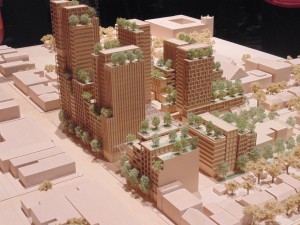
Westbank’s initial concept for Bloor and Bathurst streets includes a cluster of buildings at varying heights. Photo: Brian Burchell, Gleaner News
Cautious optimism greets Westbank proposal
By Annemarie Brissenden
Annex residents could be forgiven for thinking that creative, civic-minded developers are as rare as hen’s teeth. Long accustomed to property owners whose large and imposing concrete monstrosities loom over the area, they arrive at planning meetings prepared to fight. But what happens when the field of battle turns out to be a zone of conciliation?
Such is the case with Westbank Corp. and its plans to redevelop Mirvish Village.
“Normally you walk in [to an open house or planning meeting], have a plan put in front of you, and everybody begins to shout,” explained Neil Wright, chair of the Harbord Street Business Improvement Area. “This is a huge cultural shift: I don’t think people can comprehend it until they have had time to think.”
Shortly after a packed open house in early March, during which Westbank gave the community its first glance at the developer’s plans for the southwest corner of Bloor and Bathurst streets, residents are still trying to absorb the proposal, which is unlike anything they’ve ever seen.
“It’s quite different, and took some people by surprise,” said local councillor Mike Layton (Ward 19, Trinity-Spadina). “It’s an interesting take on how development can happen at that site. Elements of it are quite unique, and will add to the character of the neighbourhood.”
Forty to 50 interconnected buildings, the majority of which will be under 10 storeys, except for three at 29, 22, and 21 storeys, will house one thousand rental units, at least half of which will be two bedrooms or more. The buildings, which will appear to be separate when viewed from the outside, will also include live-work spaces, artist studios, and a daycare. There are plans for a covered public market, an alley with micro retail, bicycle valet parking, and auto share. And, 14 heritage buildings on Markham Street will be preserved.
Although these initial concepts for the site have not been presented to the City, Westbank is canvassing the community for feedback on its ambitious plan.
So far, the reviews are cautiously optimistic.
“At first glance, it’s very exciting, very creative,” said David Harrison, chair of the Annex Residents’ Association, who added that it’s a new idea in Toronto. “It’s all rental, [and] directionally that’s a good thing.”
“This is seriously family-style rental housing,” said Layton. “We struggle to get [developers to include] 10 to 15 per cent two and three bedrooms.”
He also praises the “beautiful little micro retail” and the public market, delighted with how the project’s architect has aimed to “replicate hundreds of years of development in Amsterdam and Paris.”
Harrison believes that’s due to the rental aspect of the project, not just because it was something the community identified as being important. “Developers are interested in investing in the public realm, because they have to live with it, as they will still own it.”
That said, it does seem as though they “are ticking all the boxes,” he said. “What’s surprising is they actually listened to so much of the input from the community groups.”
“I don’t think I’ve seen a developer get so far ahead of a process and engage the community and city planners in a dialogue that was so authentic and ultimately had an impact on the development,” agreed the chair of the Bloor-Annex Business Improvement Area, Brian Burchell, who also publishes this newspaper.
Ian Scott, a board member of the Palmerston Area Residents’ Association, said he’s mostly initially positive about the proposal, but, he noted, “discussion at the open house was directed at the things they wanted to talk about, not what we wanted to talk about.”
Among the things left out was consideration of how the area will absorb that much density.
“Have they done any studies about what traffic will look like? What will it do to the neighbourhood during construction?” asked Scott. “I am not convinced that I know enough about the scale not to be concerned about how it’s going to fit into the neighbourhood and not be disruptive in the long term.”
Other concerns raised included questions about the affordability of the units, the desire for greenspace, and the capacity of the nearby subway station.
“Neither Westbank nor the City appear to be engaging in a dialogue with [the TTC, which] is a glaring omission,” said Burchell. “Bathurst Street subway access to Bloor Street is in dire need of renewal. It can’t handle current capacity, and it’s safe to say, there will be more.”
Then there’s the height of the tallest tower.
“We’re trying to keep towers in the low twenties,” said Harrison, a comment echoed by Sue Dexter of the Harbord Village Residents’ Association.
“Twenty-nine storeys is high. That’s density that you want to be concerned about.” She’s keen to get into the nitty-gritty of the project to understand “how it would work. We don’t know how each building relates to the other, who’s going to program Markham Street,” or what the buffer from the street would be for those living in the units.
Still, Dexter views it as a positive step, even if there’s “lots of stuff to understand and there are concerns.
“Looking at the complexity of it, and marvelling at how much they’ve managed to embrace of the community,” she said, the question is, “how do you make it real?”
